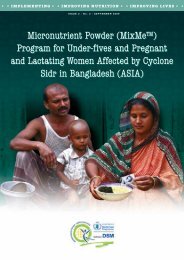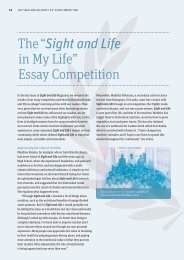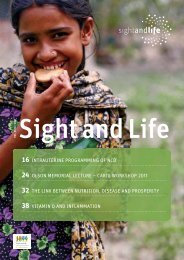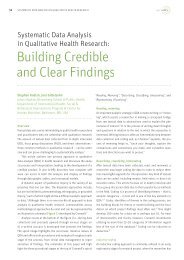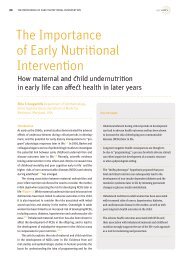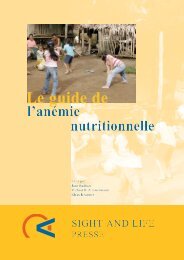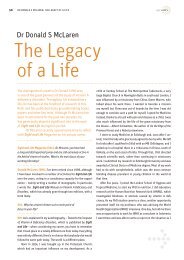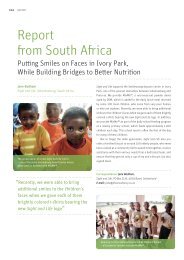Sight and Life Magazine 1/2011
Sight and Life Magazine 1/2011
Sight and Life Magazine 1/2011
Create successful ePaper yourself
Turn your PDF publications into a flip-book with our unique Google optimized e-Paper software.
52 IRON FORTIFICATION – NEW REVELATIONS?disease which was reported in 2004 to affect 1.4 million peoplein the United States, <strong>and</strong> 2.2 million in Europe. 39T reg cells are also derived from CD4 + T cells. Their importancelies in their ability to suppress the immune responses of othercells – that is, to keep the immune responses in check. The authorsshowed that the increase in Treg in response to oral inoculationwith Clostridia (spp) during the early life of conventionallyreared mice promoted anti-inflammatory immune responses<strong>and</strong> were more resistant to experimental models of allergy <strong>and</strong>experimental colitis – the murine equivalent of IBD. The paperis a fascinating piece of investigative murine microbiology but,unfortunately, there is not space to discuss it in detail. Interestingly,the ability to stimulate T regs was not blocked by SFBbacteria or Lactobacilli. A cocktail of 45 strains of Clostridia wasmore effective in raising T reg production than three strains indicating,possibly, that a number of stimuli is necessary for a fullresponse. 5 Clostridium species appear to be specialized in theirability to promote T reg cell accumulation in the colon. 25 Adherenceto the intestinal epithelium did not appear to be necessary,as in the case of SFB bacteria, possibly because Clostridia spppromoted the release of the transforming growth factor- thatstimulated CD4 + T cell differentiation. 25 The effects of these bacteriaon T-cell development give us a clear indication that, potentially,many fecal bacteria may have an important influenceon immune defenses in the gut <strong>and</strong> on the systemic health of thehost. We currently have little idea of the specific role of iron inthis “orchestra.”Concluding remarksThree papers have been discussed in this report, which describesinteractions between diet, the microbiota <strong>and</strong> the immune system.The paper by the Zimmermann group illustrates that anincrease in a poorly available form of iron was associated withalterations in the colonic microbiota <strong>and</strong> evidence of inflammationin the intestinal lining. 3 The two other papers illustrate thatspecific, or groups of, gram-positive bacteria can have stimulatoryeffects on the immune system <strong>and</strong> promote potentiallyinflammatory 4 <strong>and</strong> anti-inflammatory 5 immune responses. Theiron supplementation study identified an increase in the gramnegative,enterobacterial fecal fraction as being positively associatedwith calprotectin, a biomarker of inflammation. Therewere also increases in several species of pathogenic bacteria inthis group <strong>and</strong> some were identified in several of the children. Inaddition, there was a reduction in the gram-positive Lactobacillusgroup of bacteria.Host protection against bacterial pathogenicity is partly affordedby the large number of commensal bacteria in the microbiota,many of which will occupy important niches within theintestinal lining <strong>and</strong> so prevent occupancy by incoming pathogenicstrains. 40 Dietary requirements will also determine whichbacteria can propagate themselves at the expense of others. Ironis an important regulator of bacterial growth <strong>and</strong> pathogenicity.Supplemental iron may well have been responsible for the fourfoldincrease in the numbers of enterobacteria <strong>and</strong> the associatedinflammation. The particular bacterial species <strong>and</strong> mechanismcausing the inflammation are not known, but the markedeffects that SFB bacteria <strong>and</strong> Clostridia spp can have on T-cellregulation indicate the type of mechanism that may have beeninvolved. As the authors suggest, minimizing the inflammatoryeffects of supplemental iron may be possible with a lower doseof more bioavailable iron to promote iron uptake <strong>and</strong> reduce theamount available to the microbiota.In the last issue of <strong>Sight</strong> <strong>and</strong> <strong>Life</strong>, Barbara Troesch, from thesame group, reported on the successful use of low-dose ironfrom NaFeEDTA, in combination with ascorbic acid <strong>and</strong> phytase,to increase body iron stores <strong>and</strong> reduce iron <strong>and</strong> zinc deficiencyin South African school children. 41 It should also be rememberedthat the study in Côte d’Ivoire was intended to show the potentialeffects of food fortified with iron. In fact, the iron load was18.2 mg/day, given in a biscuit four days/week. The equivalentdaily dose of fortified iron would have been 8.8 mg iron/day, butthis amount may not have had the same microbiological or inflammatoryeffects as the higher dose. Currently, the selection ofthe type <strong>and</strong> quantity of vitamins <strong>and</strong> minerals to add to flour,either as a voluntary st<strong>and</strong>ard or a m<strong>and</strong>atory requirement, lieswith national decision-makers in each country. As a result, thechoice of compounds as well as quantities should be viewed inthe context of each country’s situation. Recommended amountsof electrolytic iron are only given where the daily consumptionof flour is >150 g (60 ppm) or >300 g (40 ppm) for low extractionflour or 20 <strong>and</strong> 15 ppm resp. for those amounts of high extractionflour. 42 Three hundred grams of flour containing 40 ppm Fe isequivalent to a daily intake of 18 mg iron, i.e. comparable to theamount used in the Ivorian children. Thus, the effects of the ironsupplement reported by Zimmermann <strong>and</strong> colleagues 3 are applicableto those countries where flour is fortified with electrolyticiron, <strong>and</strong> there is a high consumption of wheat flour.Correspondence: David I Thurnham, 46 High Street,Little Wilbraham, Cambridge CB21 5JY, United KingdomE-mail: di.thurnham@ulster.ac.uk



